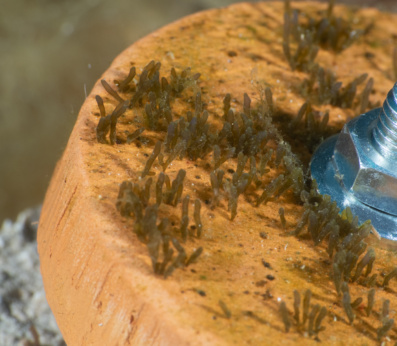The biggest update on the progress of Cystoseira the restoration in the Cilento National Park is here!
Despite the challenges posed by the late summer sea storms, the resilient, newly outplanted seedlings have not just survived but are thriving!
The REEForest project involves comprehensive and continuous monitoring activities to assess the condition of the outplanting units (metal structures supporting the young Cystoseira) and evaluate the well-being and growth of the algae.
The first post-planting monitoring phase in the Protected Area of Santa Maria di Castellabate (Cilento) has been completed.
Here, north of Punta Licosa, the Cystoseira seedlings grown in the phycological laboratory of the University of Trieste were successfully outplanted at the receiving site this summer.
In September, a team of researchers from the University of Naples Parthenope, assisted by experienced divers from Shoreline, gathered in Agropoli to investigate the sixteen concrete blocks that had been sunk in the project area three months earlier and on which the Cystoseira seedlings are growing.
The team spent a week diving almost all day, collecting photos and data and measuring the survival and growth of the thalli.
They explored both the donor area, the one from which the fertile Cystoseira apices were taken for cultivation, and the receiving area, where the Cystoseira population has almost disappeared.
Encouragingly, the team found the anchoring structures with the clay disks, located at a depth of about six meters, safely in place.
Despite the recent storms, all of the Cystoseira thalli are thriving, fostering the growth of a newborn marine forest that is already teeming with new life.
REEForest monitoring also includes the collection of samples and data (e.g. by sorbona, photogrammetry, visual census).
The collected samples will then further analyzed in the Napoli Parthenope laboratory to assess the rich biodiversity and biomass associated with macroalgal forests and evaluate the ecosystem services provided by these invaluable habitats.
This successive laboratory work requires in-depth taxonomic knowledge and long, arduous laboratory analysis.
Data on carbon storage will also be provided by the University of Trieste.
Finally, the data collected by the divers will also be used to assess the cost-benefit ratio of the restoration carried out as part of the project.
So, after a week of intensive diving, we can confidently report that everything is going as planned.
The next monitoring phase is imminent. We look forward to the day when the implanted Cystoseira is robust enough to withstand predators and storms and underpin the success of this remarkable marine restoration effort.
Stay tuned for further updates as we witness the continued growth and resilience of the Cystoseira in the heart of the Cilento National Park!






